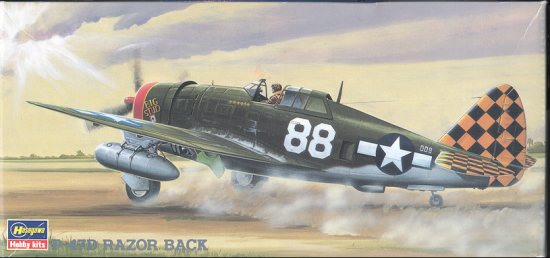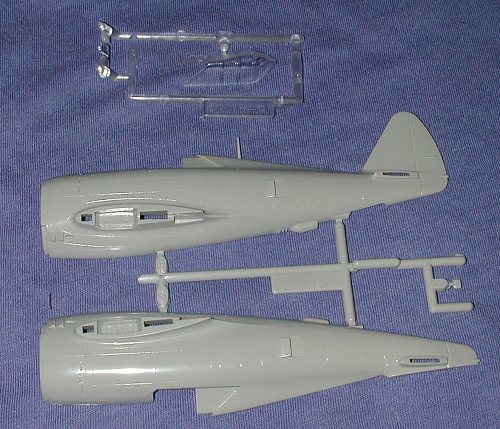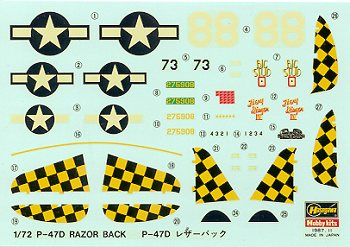
|
KIT: |
Hasegawa 1/72 P-47D Razorback |
|
KIT # |
2507 (At7) |
|
PRICE: |
$14.98 |
|
DECALS: |
Two aircraft |
|
REVIEWER: |
|
|
NOTES: |

|
HISTORY |
Most of us know the story of the 'Jug' by this time. The earliest versions had what is now called a 'razorback'. It was called this as the top of the rear fuselage formed a rather pointed appearance when compared to similar aircraft like the P-40 or P-51. Though supplanted by the 'bubble top' version with a cut down rear fuselage and all-around vision canopy, the earlier versions stayed in service until the end of the war. Unlike their later cousins, once the war was over, these aircraft were quickly removed from service and destroyed, so few were left for us to appreciate.
|
THE KIT |

I really didn't want to make this a quickie preview, but there is very little new to say about this particular kit. All that I said about the bubble top version is true of this one as well, including the improved upper wing surface. The only items different in terms of plastic from that kit are the fuselage and canopy. Those parts are shown above. Like its predecessor, the canopy is a single construct and must be cut or replaced to show any cockpit detail.
 This particular boxing, dated
1992, has decals for two aircraft (the instructions are dated 1988 so this is
undoubtedly the baseline kit). One is the box art plane from the famed 'Checkertail
Clan'; the 325 FG. Specifically, this is 'Big Stud' of pilot Robert Baseler in
Italy, circa 1944. Back when the Champlain Fighter Museum was up and operating,
they had a razorback P-47 in his markings. The other is an equally famous P-47,
'Fiery Ginger III, of pilot Neel Kirby. Col. Kirby was with the 348th FG in New
Guinea, also in 1944. His aircraft has the usual white tail and wing leading
edges of the New Guinea campaign. As is the norm with Hasegawa house decals, the
white is an ivory color and probably a bit transparent as well. However, they
work well if applied with very hot water. I find it particularly interesting
that no underside checks are supplied for the tail planes. Not sure if that is
prototypical or not. Equally interesting is that the tail markings are separated
into separate sections for the control surfaces as the control surfaces are
molded in the neutral position.
This particular boxing, dated
1992, has decals for two aircraft (the instructions are dated 1988 so this is
undoubtedly the baseline kit). One is the box art plane from the famed 'Checkertail
Clan'; the 325 FG. Specifically, this is 'Big Stud' of pilot Robert Baseler in
Italy, circa 1944. Back when the Champlain Fighter Museum was up and operating,
they had a razorback P-47 in his markings. The other is an equally famous P-47,
'Fiery Ginger III, of pilot Neel Kirby. Col. Kirby was with the 348th FG in New
Guinea, also in 1944. His aircraft has the usual white tail and wing leading
edges of the New Guinea campaign. As is the norm with Hasegawa house decals, the
white is an ivory color and probably a bit transparent as well. However, they
work well if applied with very hot water. I find it particularly interesting
that no underside checks are supplied for the tail planes. Not sure if that is
prototypical or not. Equally interesting is that the tail markings are separated
into separate sections for the control surfaces as the control surfaces are
molded in the neutral position.
Anyway, until the recent release of the Academy P-47 kits in this scale, this was the only real option for high end 1/72 P-47 enthusiasts. Jo-han did a razorback version, but it is a bit cruder than the Hasegawa offering. It would be interesting to see how the Academy kit stacks up to this one.
|
CONCLUSIONS |
This is still a fine kit and there are lots of aftermarket goodies for it, including an inexpensive resin interior by True Details that really helps the kit a lot. Highly recommended.
If you would like your product reviewed fairly and quickly by a site that has well over 150,000 visitors a month, please contact me or see other details in the Note to Contributors.